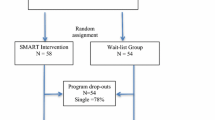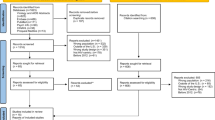Abstract
Internet delivered primary prevention interventions for HIV risk reduction present significant challenges. Changing lifestyle behaviors, such as beginning to use condoms, is difficult and men seeking dates on line may want to avoid thinking about HIV risk which may lead to low initiation and high dropout rates. Many Internet delivered HIV risk reduction programs have mimicked face-to-face outreach programs, failing to take advantage of the Internet’s capabilities or did not conduct evaluation. This study focuses on examining the feasibility, acceptability, and efficacy of an Internet delivered HIV risk reduction program for rural men who have sex with men (MSM). The program included online recruiting, three intervention modules, each with two sessions, online questionnaires. The intervention was developed based on iterative research and the Information-Motivation-Behavioral skills model. Participants (N = 475) were randomly assigned to one of six module orders and data were collected automatically at pre-test and after each module. Data supports the feasibility and acceptability of the program as demonstrated by good retention and rapid program completion. Knowledge, self-efficacy, outcome expectancies and motivation increase in a dose response fashion. Post-intervention behavior changes included reduced anal sex and significant increases in condom use. Limitations include a short follow-up period, a predominantly young white rural sample, and the lack of an attention control. Overall the results of the study provide support for the efficacy of Internet-based interventions to reduce risk of HIV infection. Results also support traditional research methods to evaluate HIV prevention programs delivered exclusively through the Internet.

Similar content being viewed by others
References
Andersson, G., Bergström, J., Holländare, F., Calrbring, P., Kaldo, V., & Ekselius, L. (2005). Internet-based self-help for depression: Randomized controlled trial. The British Journal of Psychiatry, 187, 456–461. doi:10.1192/bjp.187.5.456.
Benotsch, E. G., Wright, V. J., de Roon Cassini, T. A., Pinkerton, S. D., Weinhardt, L., & Kelly, J. A. (2006). Use of the Internet for HIV prevention by AIDS service organizations in the United States. Journal of Technology in Human Services, 24, 19–35. doi:10.1300/J017v24n01_02.
Binik, Y. M. (2001). Sexuality and the Internet: Lots of hyp(otheses)—Only a little data. Journal of Sex Research, 38(4), 281–282.
Bowen, A. M. (2005). Internet sexuality research with rural MSM: Can we recruit and retain them? Journal of Sex Research, 42(4), 317–323.
Bowen, A. M., Daniel, C. M., Williams, M. L., & Baird, G. L. (2008). Identifying multiple submissions in Internet research: Preserving data integrity [Electronic Version]. Aids & Behavior. Retrieved June 6, 2008, from http://www.springerlink.com/content/k88345806vwwh106/fulltext.pdf.
Bowen, A. M., Horvath, K., & Williams, M. L. (2006). Randomized control trial of an Internet delivered HIV knowledge intervention with MSM. Health Education Research, 22(1), 120–127. doi:10.1093/her/cyl057.
Bowen, A. M., Williams, M. L., & Horvath, K. (2004). Using the Internet to recruit rural MSM for HIV risk assessment: Sampling issues. AIDS and Behavior, 8(3), 311–319. doi:10.1023/B:AIBE.0000044078.43476.1f.
Buhrman, M., Faltenhag, S., Strom, L., & Andersson, G. (2004). Controlled trial of Internet-based treatment with telephone support for chronic back pain. Pain, 111, 368–377. doi:10.1016/j.pain.2004.07.021.
Bull, S., Lloyd, L., Reitmeijer, C., & McFarlane, M. (2004). Recruitment and retention of an online sample for an HIV prevention intervention targeting men who have sex with men: the Smart Sex Quest Project. AIDS Care, 16(8), 931–943. doi:10.1080/09540120412331292507.
Bull, S. S., McFarlane, M., & King, D. (2001). Barriers to STD/HIV prevention on the Internet. Health Education Research, 16(6), 661–670. doi:10.1093/her/16.6.661.
Carlbring, P., Nilsson-Ihrfelt, E., Waara, J., Kollenstam, C., Buhrman, M., Kaldo, V., et al. (2005). Treatment of panic disorder: Live therapy vs. self-help via the Internet. Behaviour Research and Therapy, 43, 1321–1333. doi:10.1016/j.brat.2004.10.002.
Carlbring, P., Westling, B., Ljungstrand, P., Ekselius, L., & Andersson, G. (2001). Treatment of panic disorder via the Internet: A randomized trial of a self-help program. Behavior Therapy, 32, 751–764. doi:10.1016/S0005-7894(01)80019-8.
Devineni, T., & Blanchard, E. B. (2005). A randomized controlled trial of an internet-based treatment for chronic headache. Behaviour Research and Therapy, 43, 277–292. doi:10.1016/j.brat.2004.01.008.
Fisher, J., & Fisher, W. (1992). Changing AIDS-risk behavior. Psychological Bulletin, 111, 455–474. doi:10.1037/0033-2909.111.3.455.
Fisher, J. D., Fisher, W. A., Bryan, A. D., & Misovich, S. J. (2002). Information-motivation-behavioral skills model-based HIV risk behavior change intervention for inner-city high school youth. Health Psychology, 21, 177–186. doi:10.1037/0278-6133.21.2.177.
Fisher, W., & Fisher, J. (1993). A general social psychological model for changing AIDS risk behavior. In J. Pryor & G. Reeder (Eds.), The social psychology of HIV infection (pp. 127–155). Hillsdale: Lawrence Erlbaum Associates, Inc.
Fox, S., & Fallows, D. (2003). Internet health resources health searches and email have become more commonplace, but there is room for improvement in searches and overall Internet access. Washington, DC: Pew Internet & American Life Project.
Glasgow, R., Boles, S., McKay, H., Feil, E., & Barrera, M. (2003). The D-Net diabetes self-management program: Long-term implementation outcomes, and generalization results. Preventive Medicine, 26, 103–106.
Hunter, C. M., Peterson, A. L., Alvarez, L. M., Poston, W. C., Brundige, A. R., Haddock, C. K., et al. (2008). Weight management using the Internet. American Journal of Preventive Medicine, 34, 119–126. doi:10.1016/j.amepre.2007.09.026.
Kalichman, S. C., Picciano, J. F., & Roffman, R. A. (2008). Motivation to reduce HIV risk behaviors in the context of information, motivation and behavioral skills (IMB) model of HIV prevention. Journal of Health Psychology, 13, 680–689. doi:10.1177/1359105307082456.
Kling, R., Lee, Y., Teich, A., & Frankel, M. S. (1999). Assessing anonymous communication on the internet: Policy deliberations. The Information Society, 15, 79–90. doi:10.1080/019722499128547.
Kok, G., Harterink, P., Vriens, P., de Zwart, O., & Hospers, H. J. (2006). The gay cruise: Developing a theory- and evidence-based Internet HIV-prevention intervention. Sexuality Research & Social Policy, 3, 52–67. doi:10.1525/srsp.2006.3.2.52.
Konstan, J., Rosser, B. R. S., Ross, M., Stanton, J., & Edwards, W. (2005). The story of subject naught: A cautionary but optimistic tale of internet survey research [Electronic Version]. Journal of Computer-Mediated Communication, 10. Retrieved June 3, 2008, from http://jcmc.indiana.edu/vol10/issue2/konstan.html.
McCoy, M., Couch, D., Duncan, N., & Lynch, G. (2005). Evaluating an Internet weight loss program for diabetes prevention. Health Promotion International, 20, 221–228. doi:10.1093/heapro/dai006.
McFarlane, M., Kachur, R., Klausner, J. D., Roland, E., & Cohen, E. (2005). Internet-based health promotion and disease control in the 8 cities: Successes, barriers, and future plans. Sexually Transmitted Diseases, 32, s60–s64. doi:10.1097/01.olq.0000180464.77968.e2.
McKay, H., King, D., Eaking, E., Seeley, J., & Glasgow, R. (2001). The diabetes network Internet-based physical activity intervention: A randomized pilot study. Diabetes Care, 24, 1328–1334. doi:10.2337/diacare.24.8.1328.
Milgram, S. (1965). Some conditions of obedience and disobedience to authority. Human Relations, 18, 57–76. doi:10.1177/001872676501800105.
Mustanski, B. S. (2001). Getting wired: Exploiting the Internet for the collection of valid sexuality data. Journal of Sex Research, 38(4), 292–301.
Norman, G. J., Zabinski, M. F., Adams, M. A., Rosenberg, D. E., Yaroch, A. L., & Atienza, A. A. (2007). A review of ehealth interventions for physical activity and dietary behavior change. American Journal of Preventive Medicine, 33, 336–345.
Oenema, A., Brug, J., Dijkstra, A., de Weerdt, I., & de Bries, H. (2008). Efficacy and use of an Internet-delivered computer-tailored lifestyle intervention, targeting saturated fat intake, physical activity and smoking cessation: A randomized controlled trial. Annals of Behavioral Medicine, 35, 125–135. doi:10.1007/s12160-008-9023-1.
Orne, M. T. (1969). Demand characteristics and the concept of quasi-controls. In R. Rosenthal & R. L. Rosnow (Eds.), Artifact in behavioral research (p. 145). New York: Academic Press.
Paxton, S. J., McLean, S. A., Gollings, E. K., Faulkner, C., & Wertheim, E. H. (2007). Comparison of face-to-face and internet interventions for body image and eating problems in adult women: An RCT. International Journal of Eating Disorders, 40, 692–704.
Pequegnat, W., Rosser, B. R. S., Bowen, A. M., Bull, S. S., DiClemente, R., Bockting, W. O., et al. (2006). Conducting Internet-based HIV/STD prevention survey research: Considerations in design and evaluation. AIDS and Behavior, 11, 505–521. doi:10.1007/s10461-006-9172-9.
Rickette, T. C., & Gesler, W. M. (1992). Health in rural North America. New Brunswick: Rutgers University Press.
Rickette, T. C., Savitz, L. A., Gesler, W. M., & Osborne, D. N. (1997). Using geographic methods to understand health issues. Washington, DC: DHHS, U.S. Public Health Service.
Ross, M., Rosser, B. R. S., Stanton, J., & Konstan, J. (2004). Characteristics of Latino men who have sex with men on the Internet who complete and drop out of an Internet-based sexual behavior survey. AIDS Education and Prevention, 16, 526–537. doi:10.1521/aeap.16.6.526.53793.
Saitz, R., Helmuth, E., Aromaa, S., Guard, A., Belanger, M., & Rosenbloom, D. (2004). Web-based screening and brief intervention for the spectrum of alcohol problems. Preventive Medicine, 39, 969–975. doi:10.1016/j.ypmed.2004.04.011.
Vandelanotte, C., Spathonis, K. M., Eakin, E. G., & Owen, N. (2007). Website-delivered physical activity interventions: A review of the literature. American Journal of Preventive Medicine, 33, 54–64. doi:10.1016/j.amepre.2007.02.041.
Wangberg, S. C. (2008). An Internet-based diabetes self-care intervention tailored to self-efficacy. Health Education Research, 23, 170–179. doi:10.1093/her/cym014.
Williams, M. L., Bowen, A. M., Clayton, S., & Ei, S. (in press). An evaluation of the experiences of rural MSM who accessed an internet delivered HIV risk reduction intervention. Health Promotion Practice.
Williams, M. L., Bowen, A. M., & Horvath, K. (2005). The social/sexual environment of gay men residing in a rural frontier state: Implications for the development of HIV prevention programs. The Journal of Rural Health, 21, 48–55. doi:10.1111/j.1748-0361.2005.tb00061.x.
Ybarra, M., & Bull, S. S. (2007). Current trends in Internet- and cell phone-based HIV prevention and intervention programs. Current HIV/AIDS Reports, 4, 201–207. doi:10.1007/s11904-007-0029-2.
Acknowledgments
This study was supported by a grant from the National Institute of Mental Health (MH-63667); The Wyoming Rural AIDS Prevention Projects. All work and opinions herein are solely those of the authors.
Author information
Authors and Affiliations
Corresponding author
Rights and permissions
About this article
Cite this article
Bowen, A.M., Williams, M.L., Daniel, C.M. et al. Internet based HIV prevention research targeting rural MSM: feasibility, acceptability, and preliminary efficacy. J Behav Med 31, 463–477 (2008). https://doi.org/10.1007/s10865-008-9171-6
Received:
Accepted:
Published:
Issue Date:
DOI: https://doi.org/10.1007/s10865-008-9171-6




